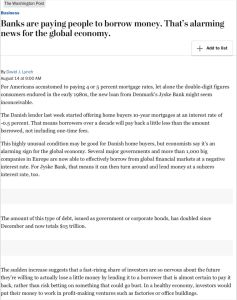Join getAbstract to access the summary!

Join getAbstract to access the summary!
David J. Lynch
Banks are paying people to borrow money. That’s alarming news for the global economy.
The Washington Post, 2019
What's inside?
Some investors are so uncertain about the future that they are willing to lend money at a loss.
Recommendation
In early August 2019, a Danish bank began to offer 10-year mortgages at negative interest rates, which means that people will end up owing less than what they borrow. That sounds terrific for potential homeowners but terrible for banks and, potentially, the global economy. In this eye-opening article, journalist David J. Lynch explores how this topsy-turvy world of below-zero interest rates is working now in Europe and Japan, and why it could happen in the United States as well.
Summary
About the Author
David J. Lynch is a financial writer for The Washington Post.

















Comment on this summary